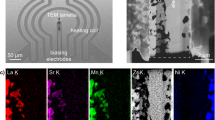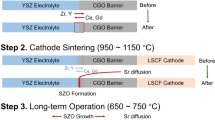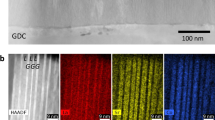Abstract
The drive towards increased energy efficiency and reduced air pollution has led to accelerated worldwide development of fuel cells. As the performance and cost of fuel cells have improved, the materials comprising them have become increasingly sophisticated, both in composition and microstructure. In particular, state-of-the-art fuel-cell electrodes typically have a complex micro/nano-structure involving interconnected electronically and ionically conducting phases, gas-phase porosity, and catalytically active surfaces1. Determining this microstructure is a critical, yet usually missing, link between materials properties/processing and electrode performance. Current methods of microstructural analysis, such as scanning electron microscopy, only provide two-dimensional anecdotes of the microstructure, and thus limited information about how regions are interconnected in three-dimensional space. Here we demonstrate the use of dual-beam focused ion beam–scanning electron microscopy to make a complete three-dimensional reconstruction of a solid-oxide fuel-cell electrode. We use this data to calculate critical microstructural features such as volume fractions and surface areas of specific phases, three-phase boundary length, and the connectivity and tortuosity of specific subphases.
This is a preview of subscription content, access via your institution
Access options
Subscribe to this journal
Receive 12 print issues and online access
$259.00 per year
only $21.58 per issue
Buy this article
- Purchase on Springer Link
- Instant access to full article PDF
Prices may be subject to local taxes which are calculated during checkout




Similar content being viewed by others
References
Brandon, N. P., Skinner, S. & Steele, B. C. H. Recent advances in materials for fuel cells. Annu. Rev. Mater. Res. 33, 183–213 (2003).
Adler, S. B. Factors governing oxygen reduction in solid oxide fuel cell cathodes. Chem. Rev. 104, 4791–4843 (2004).
Jiang, S. P. & Chan, S. H. A review of anode materials development in solid oxide fuel cells. J. Mater. Sci. 39, 4405–4439 (2004).
Kenjo, T. & Nishiya, M. LaMnO3 air cathodes containing ZrO2 electrolyte for high temperature solid oxide fuel cells. Solid State Ion. 57, 295–302 (1992).
Svensson, A. M., Sunde, S. & Nisancioglu, K. A mathematical model of the porous SOFC electrode. Solid State Ion. 86, 1211–1216 (1996).
Virkar, A. V., Chen, J., Tanner, C. W. & Kim, J. W. The role of electrode microstructure on activation and concentration polarizations in solid oxide fuel cells. Solid State Ion. 131, 189–198 (2000).
Sunde, S. Simulations of composite electrodes in fuel cells. J. Electroceram. 5, 153–182 (2000).
Murray, E. P., Tsai, T. & Barnett, S. A. Oxygen transfer processes in (La,Sr)MnO3/Y2O3-stabilized ZrO2 cathodes: an impedance spectroscopy study. Solid State Ion. 110, 235–243 (1998).
Tiedemann, W. H. & Newman, J. S. Porous electrode theory with battery applications. AIChE J. 21, 25–41 (1975).
Zhao, F., Jiang, Y., Lin, G. Y. & Virkar, A. V. in Solid Oxide Fuel Cell VII (ed. Singhal, S. C.) 501–510 (The Electrochemical Society, Pennington NJ, 2001).
Deng, X. & Petric, A. Geometrical modeling of the triple-phase boundary in solid oxide fuel cells. J. Power Sources 140, 297–303 (2005).
Wang, C. T. & Smith, J. M. Tortuosity factors for diffusion in catalyst pellets. AIChE J. 29, 132–136 (1983).
Fleig, J. & Maier, J. The influence of laterally inhomogeneous contacts on the impedance of solid materials: a three-dimensional finite-element study. J. Electroceram. 1, 73–89 (1997).
Tanner, C. W., Fung, K. Z. & Virkar, A. V. The effect of porous composite electrode structure on solid oxide fuel cell performance. J. Electrochem. Soc. 144, 21–30 (1997).
Stevenson, J. W. et al. in Proc. 8th Int. Symp. on Solid Oxide Fuel Cells (eds Singhal, S. C. & Dokiya, M.) 31–42 (The Electrochemical Society, Pennington NJ, 2003).
Kim, J. W., Virkar, A. V., Fung, K. Z., Mehta, K. & Singhal, S. C. Polarization effects in intermediate temperature, anode-supported solid oxide fuel cells. J. Electrochem. Soc. 146, 69–78 (1999).
Brown, M., Primdahl, S. & Mogensen, M. Structure/performance relations for Ni/Yttria-stabilized zirconia anodes for solid oxide fuel cells. J. Electrochem. Soc. 147, 475–485 (2000).
Hansen, K. V., Norrman, K. & Mogensen, M. H2–H2O–Ni–YSZ electrode performance: Effect of segregation to the interface. J. Electrochem. Soc. 151, A1436–A1444 (2004).
Lin, Y., Zhan, Z., Liu, J. & Barnett, S. A. Direct operation of solid oxide fuel cells with methane fuel. Solid State Ion. 176, 1827–1835 (2005).
Liu, J. & Barnett, S. A. Thin YSZ electrolyte solid oxide fuel cells by centrifugal casting. J. Am. Ceram. Soc. 85, 3096–3098 (2002).
Sakamoto, S., Taira, H. & Takagi, H. Effective electrode reaction area of cofired type planar SOFC. Denki Kagaku 64, 609–613 (1996).
Norby, T. in Proc. 2nd European Solid Oxide Fuel Cell Forum (Oslo, Norway) (ed. Thorstenen, B.) 607–616 (Dr Ulf Bossel, Oberrohrdorf, Switzerland, 1996).
Bieberle, A., Meier, L. P. & Gauckler, L. J. The electrochemistry of Ni pattern anodes used as solid oxide fuel cell model electrodes. J. Electrochem. Soc. 148, A646–A656 (2001).
Mizusaki, J. et al. Preparation of nickel pattern electrodes on YSZ and their electrochemical properties in H2–H2O atmospheres. J. Electrochem. Soc. 141, 2129–2134 (1994).
Zhao, F. & Virkar, A. V. Dependence of polarization in anode-supported solid oxide fuel cells on various cell parameters. J. Power Sources 141, 79–95 (2005).
Zalc, J. M., Reyes, S. C. & Iglesia, E. The effects of diffusion mechanism and void structure on transport rates and tortuosity factors in complex porous structures. Chem. Eng. Sci. 59, 2947–2960 (2004).
Acknowledgements
The authors at Northwestern University, University of Washington, and University of Michigan gratefully acknowledge the financial support of the National Science Foundation Ceramics program (DMR-0542740, DMR-0542619 and DMR-0542874). They also thank Functional Coating Technology LLC for providing the SOFC described here. The FIB–SEM was carried out in the Electron Microscopy Center at Argonne National Laboratory, which is supported by the US Department of Energy, Office of Science, under Contract W-31-109-ENG-38.
Author information
Authors and Affiliations
Corresponding authors
Ethics declarations
Competing interests
The authors declare no competing financial interests.
Supplementary information
Supplementary Information
Supplementary information and figures S1, S2 (PDF 1178 kb)
Rights and permissions
About this article
Cite this article
Wilson, J., Kobsiriphat, W., Mendoza, R. et al. Three-dimensional reconstruction of a solid-oxide fuel-cell anode. Nature Mater 5, 541–544 (2006). https://doi.org/10.1038/nmat1668
Received:
Accepted:
Published:
Issue Date:
DOI: https://doi.org/10.1038/nmat1668
This article is cited by
-
A lightweight transformer for faster and robust EBSD data collection
Scientific Reports (2023)
-
Heterogeneous 3D Morphological Evolution of Ni Microparticles in Molten Salts: Visualized by Operando Synchrotron X-ray Nano-tomography
JOM (2023)
-
Simulation of Fracture Formation in Solid Oxide Fuel Cell Anode Using Peridynamic Modeling Method
Journal of Peridynamics and Nonlocal Modeling (2022)
-
Solid-State Electrochemistry and Solid Oxide Fuel Cells: Status and Future Prospects
Electrochemical Energy Reviews (2022)
-
Modeling dye-sensitized solar cells with graphene based on nanocomposites in the Brillouin zone and density functional theory
Journal of the Korean Ceramic Society (2021)



